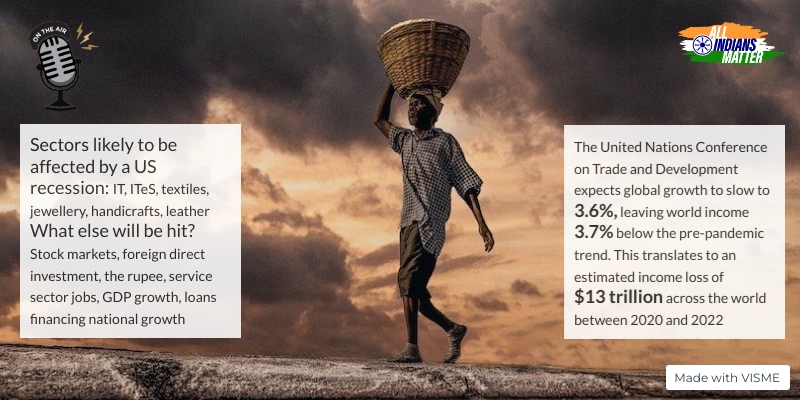Ashraf Engineer
July 2, 2022
EPISODE TRANSCRIPT
Hello and welcome to All Indians Matter. I am Ashraf Engineer.
Over the past few weeks, talk of an ‘induced’ recession in the US has been gaining ground. What it means is that, given the red-hot inflation, the US Federal Reserve has put in place a plan to raise interest rates that would create a short, mild recession that would cool inflation to manageable levels. The Federal Reserve hasn’t accepted that it’s trying to induce a recession but many experts believe that it is imminent, starting either late this year or in mid-2023. So, why am I talking about something likely to happen in the US on this podcast? It’s because India would not be immune to economic turbulence there. In fact, a recession in the US would affect you profoundly.
SIGNATURE TUNE
Recently, the Federal Reserve raised the interest rate by three-quarters of a percentage point, the steepest rise since 1994 and its most aggressive move against inflation, sparked by various reasons – from Russia’s invasion of Ukraine to rising energy prices to supply chain disruptions caused by the COVID-19 pandemic.
Inflation is a severe risk to the average citizen and the near consensus among economic experts is that the Federal Reserve will keep hiking interest rates in order to reduce money supply and thus break inflation. Only, they could well risk breaking the US economy, which is the engine of the world, representing 30% of global GDP.
Inflation is the latest global pandemic. A Pew Research Center analysis of 44 advanced economies found that in nearly all of them consumer prices rose substantially after the pandemic. In 37 of these countries, the average annual inflation rate in the first quarter of this year was at least twice that of the first quarter of 2020. In 16 countries, first-quarter inflation was more than four times that level.
This has affected consumer spending across the world, impacting the post-COVID recovery. This year, the United Nations Conference on Trade and Development expects global growth to slow to 3.6%, leaving world income 3.7% below the pre-pandemic trend. This translates to an estimated income loss of $13 trillion across the world between 2020 and 2022.
It is in this context that we must view the US raising interest rates. Loans will get costlier in the US and consumer demand and spending would reduce, and eventually so would prices as a response to that reduced demand.
US money managers would start pulling out money from developing economies, which would impact stock markets, their overall economic growth and it would depreciate their currencies. It would also reduce their foreign exchange reserves.
India would certainly see all these impacts as well as a decline in foreign direct investment. The loans the country takes to finance its growth and social programmes would also get costlier.
This year, the Indian rupee has been among the worst performing among Asian currencies, getting within touching distance of the 79-rupees-to-the-dollar mark. Compared to net positive investments of Rs 25,752 crore in 2021, foreign investors have pulled out a net Rs 1.92 lakh crore in the first five months of 2022. Meanwhile, rising crude oil prices continue to pressure the currency and the cost of living.
The Reserve Bank of India is not immune to raising rates either. Earlier in June, it hiked the key interest rate to 4.9% from 4.4% as a response to the stubborn inflation the country has been experiencing.
The US’ slowdown will certainly hamper India’s growth trajectory. The US constitutes around 18% of India’s merchandise export market and over 60% of India’s IT and IT-enabled services exports.
In fact, the IT industry will be among the worst hit. A survey of CIOs by global brokerage and research firm JPMorgan said that IT budgets would contract and 39% of the CIOs expected to delay or defer their IT purchases in the second half of this year.
The report indicated that CIOs using Indian IT companies like Tata Consultancy Services, Infosys and Wipro would cut their spending with them. This would affect jobs and also the share prices of these firms. IT firms are struggling already with shrinking margins and a cut in US spends would mean more bad news.
Other than IT and IT-enabled services, textiles, jewellery, handicrafts and leather industries would suffer losses too. Perhaps the worst affected would be the service sector as a whole, of which business process outsourcing, IT, ITeS, etc, are a part but which also includes trading, financial and professional services, education, healthcare and so on. Services contribute about 54% of India’s GDP.
Again, the key worry will be job losses.
Perhaps the only silver lining is that the US recession is at least six months away and will most likely be mild. It’s also likely to be shortlived. But, make no mistake, India will not escape its impact.
Thank you all for listening. Please visit allindiansmatter.in for more columns and audio podcasts. You can follow me on Twitter at @AshrafEngineer and @AllIndiansCount. Search for the All Indians Matter page on Facebook. On Instagram, the handle is @AllIndiansMatter. Email me at editor@www.allindiansmatter.in. Catch you again soon.






